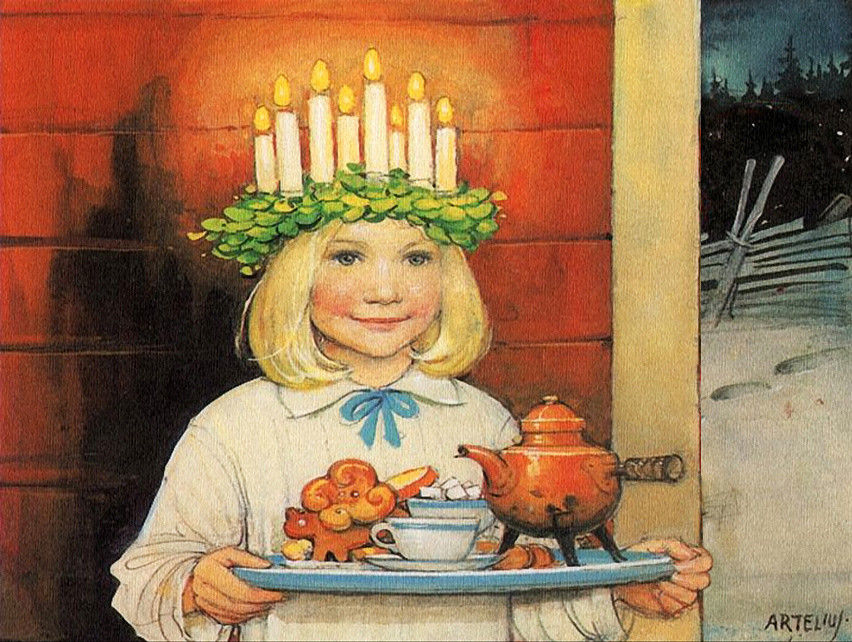St. Lucia
- Elizabeth D. Mosolovich

- Dec 13, 2019
- 3 min read
Updated: Sep 21, 2020
December -- the end of the year, bringing with it the cold and darkness (at least in the Northern Hemisphere) but also fun things like snow and an excuse to stay inside and watch TV all day.
There are many holidays to celebrate in December. Christmas, of course, full of good cheer, hope, peace, and presents, as well as St. Nicolas' Day on Dec. 6, when European children receive their presents from Santa Claus. Many December holidays feature candles, partly to celebrate the return of light after the longest night of the year on the Winter Solstice, including Hanukkah, also known as the Festival of Lights, and Kwanzaa. It is also believed that the date of Christmas, December 25th, was fixed to coincide with and eventually replace pagan winter solstice celebrations, such as the Roman Saturnalia.
Among the numerous December/winter holidays is the feast of St. Lucia, celebrated in Scandinavia on December 13th. Commemorating a young woman martyred in 304 AD, this day starts the Christmas season in Sweden and its neighboring countries.
Alternate Name: Sankta Lucia Day; Luciadagen; Luciadag; Luutsinapäev
Date: December 13th
Place: Scandinavia, Italy, Bosnia, Croatia, Malta, United States
Type: National; Religious
Celebrants: Christians; Scandinavians; Bosnians; Croatians; Italians; Americans
St. Lucia, whose name means "light", lived in Italy during the 4th century. She is the patron saint of many Italian cities such as Syracuse. It is said that she vowed never to marry and consecrated herself to God, but an angry suitor accused her of being a Christian, which at the time was illegal in the Roman Empire; this is a traditional story told about many early martyrs and saints such as Sts. Agnes and Agatha. Allegedly, part of Lucia's torture was having her eyes gouged out, or else she gouged them out herself as part of her dedication to God, and is therefore also the patroness of the blind and those suffering from eye illnesses. She is often depicted in art with a pair of eyes on a plate and a palm branch, the symbol of victory in martyrdom.
St. Lucia's Day is held on December 13th, which in the Julian calendar is the Winter Solstice. This festival is primarily celebrated in Sweden, Denmark, Norway, and Finland, especially as a day to celebrate the return of light and longer days after the solstice. It's likely that older, pre-Christian traditions contributed to the popularity of St. Lucia's Day, such as Yule or jól -- a pagan midwinter holiday that honored the chief Norse god Odin -- and Lussinatta, which was also celebrated on Dec. 13. An evil or mischievous spirit similar to figures like Krampus, the Lussi flies across the sky on this night with a horde of trolls, goblins, and other spirits; it was considered dangerous to be outside at that time. Lussi would also enter people's homes through the chimney, punishing lazy parents and badly-behaved children.
Nowadays in Sweden, people celebrate Dec. 13th with parades and special food, such as ginger snap biscuits called pepparkakor, and Lussekatts, St Lucia's Day buns made with saffron and raisins. The eldest daughter of the house is usually appointed as "Lucia" for the day and serves the food to her family. Towns and villages often choose their own "Lucia" who appears in a procession wearing a white robe and a red sash, as well as a wreath of candles on her head, which can be either real ones or battery-operated. Connected to this tradition is a story that St. Lucy would give food to Christian prisoners, lighting the way with candles on her head so she could carry more food in her hands. In the procession, the "Lucia" might be accompanied by boys called stjärngossar, or "star boys" and tärnor, girls dressed like Lucia but without the candles.
Other traditions are held throughout Europe. In Hungary and Croatia, for example, it is traditional to plant wheat grains on this day so they will be slightly grown by Christmas, celebrating the coming of new life. Also, due to the large amount of Germanic- and Scandinavian-descended families in the United States, St. Lucia's Day is celebrated in those communities. Gustavus Adolphus College in Minnesota, founded by Swedish Americans in 1862, for example, celebrates Dec. 13 by choosing six sophomore women to be Lucia and her court; the court goes caroling in the morning and eats Scandinavian food like lutefisk and lefse.
~
I hope you all enjoyed learning about St. Lucia's Day! As always, please reach out to me if I have misrepresented anything, or if there's a specific holiday or celebration you would like to see on Celebrate the World!
Happy Holidays to everyone no matter what you may celebrate. See you next time!
References






Comments